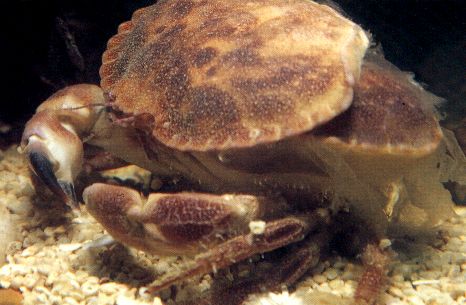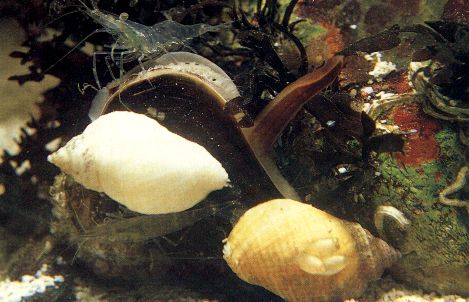
September |
||||||||
| Low tides at the beginning of September may
be the last opportunity the rockpooler has to
get down to the shore before the autumnal gales make a visit inhospitable.
The long tides that recede uncovering areas of the sea bed that are
submerged for most of the year mean that September can often be a rewarding
month. Wrasse and other small fish that have hatched
earlier in the year will have grown a few centimetres since August, but
there will be less of them. Only the fittest and strongest will survive
in the sea where large fish relentlessly devour smaller prey
OVERCROWDING By September the rockpooler-aquarist may find that his, or her, tanks are getting crowded. August is usually the month when the small fish and other animals between the tides are found in the greatest numbers and greatest variety. The aquarist should be very strict and collect only what he has room for. There are two hazards. Firstly, an overcrowded bucket can cause the fish to suffocate on the journey home. Even more seriously, an overcrowded aquarium can result in the demise of all its inhabitants. Stocking levels can be on a par with a tropical aquaria for the smaller rock pool fish, but with plenty of aeration I use a supplementary powerhead to agitate the surface water. However, the fish collected in August will have grown by September and some may be nearly double the size. This will mean that they need to be stocked at levels a quarter of what they were the previous month. There is the temptation to introduce into the aquarium further captures during September. Be very careful and heed on the side of caution. I have known aquarists introduce masses of prawns during September,
partly as live food, only to see many of the larger fish that were meant
to eat the prawns suffer. The prawns were blamed for introducing disease,
but the ailments probably arose from an overcrowded tank, with a shortfall
in dissolved oxygen and excess ammonia and nitrite levels contributing
to the ill health.
MARINE AQUARIA Hopefully, the best way to become a better marine aquarist would be to learn by other people's mistakes. Like any other subject, the hobby of aquaria, or science of aquariology, involves a mixture of learning by books, or apprenticeship, experience allied by thinking, or applying the fruits of your education and observations. There are two names to look out for in books on marine aquaria Dick Mills for the newcomer to the Hobby, and Stephen Spotte for advanced study. There are a few other writers to look out for as well, but the object of the column this month is to make some further suggestions for reading outside the aquarium field. Books about the sea and oceanography can give the aquarist an insight in the chemistry and physics of the oceans and the multitude of marine animals. Even more useful are books on the animals themselves and books on marine biology. If you keep crabs in aquaria, a book about these crustaceans will explain aspects of their life cycle, involving the moult, or ecdysis when the crab has to shed its old shell, or exoskeleton, so that it can grow. Beware of drawing simple conclusions from inadequate evidence! Test kits are invaluable for monitoring the conditions in aquaria, but are much less useful in diagnosing problems. Let us examine a typical problem encountered by a beginner. Diligently reading all the books and installing the most advanced equipment, the aquarium thrives for a year and then one of the fish dies. The aquarist checks the ammonia, nitrite and nitrate readings and find that the nitrates in the tanks measuring a whacking 500mg/l. He concludes that an excess in nitrates is the problem, changes the water and installs a nitrate filter. The problem disappears and the remaining fish continue to thrive. The aquarist may then conclude that this particular fish is intolerant of high nitrates and this was the reason for its death. Alas, although this may have been the case, it is no means the only possibility or even the most likely reason. As the tank matures and becomes established, lots of other biological events occur of which the build up of the biomass in the aquarium should be evaluated Bacteria and small organisms multiple in the filter bed and on rocks
and other surfaces and all these organisms use of up valuable oxygen. The
aquarist could equally conclude that the fish died because of a shortfall
of dissolved oxygen, but there are lots of other reasons like stress and
inadequate nutrition that could be responsible.
DOGWHELK The Dogwhelk, NucelLapillus, is a carnivorous marine snail that is common on rocky shores where it feeds on acorn barnacles by smothering this sessile crustacean, and attacks and eats mussels by boring a hole in the hard shell and sucking out the rich orange flesh. The Dogwhelk can be kept in aquaria where it can be observed feeding. This marine snail comes in different colours but many of them are all white or a dirty grey-purple in colour. A white specimen in my tank fed on a mussel and in the succeeding weeks turned grey. Can I conclude the obvious that the Dogwhelk changed colour because of what it ate? The answer is no! I can suggest it as a hypothesis, but the mussel may have changed colour for other environmental reasons or because of a genetic inheritance? Further study is necessary. Further Dogwhelks were introduced and most of these did not change colour.
Is there something in the pigment in the flesh of the mussel that causes
the colour change? The results were inconclusive. There is still a lot
to be learned about the life on the seashore.
MARINE AQUARIUM BOOKS Interpet Encyclopaedia of Marine Aquaria, by Dick Mills (Salamander). Marine Aquarium Keeping, by Stephen Spotte (John Wiley & Sons).
|
||||||||
|
||||||||


